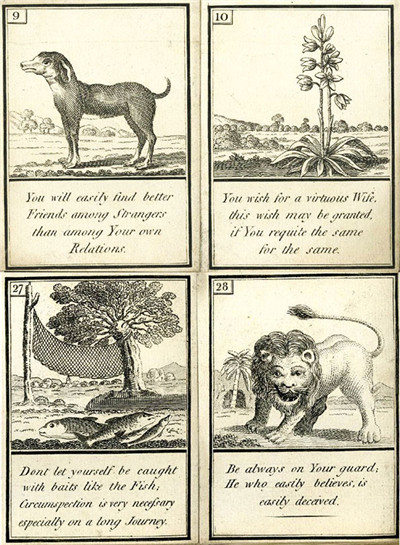The game's original instructions said it could be used for divining because the illustration on each card included both a symbolic image, like the anchor, and a specific playing card, like the nine of spades. "Hechtel must have seen that there were overlaps between divining with playing cards, which, of course, everyone did, and his game," says Matthews. "Many other oracle decks appeared around the same time at the end of the 18th century and into the early 19th century. They became really popular after the Napoleonic Wars when everyone settled down and became terribly bourgeois.
最初這種游戲的玩法就顯示出它可以被用作占卜,因為每一張牌上都畫有比如像錨這樣有象征意義的圖案,或者其本身就有特殊寓意,如黑桃五。“德國人Hechtel肯定預見了他的紙牌游戲和占卜之間會產生聯系,當然,很多那時候的人也就是那樣做的,”Matthews說。“在十八世紀晚期到十九世紀剛開始之間產生了很多種神諭牌,它們之所以變得流行是因為與拿破侖之間發生的戰爭結束了,社會變得安定下來,資本主義蓬勃發展。”
"Quite recently, it was discovered by Mary Greer that there was a prior source to the Lenormand cards," she continues. “There's a deck in the British Museum called ‘Les Amusements des Allemands' (‘The German Entertainment'). Basically, a British firm put together a pack of cards that has images and little epigrams on the bottom, which say things like, ‘Be aware, don't spend your money unwisely,' and that sort of thing. It's quite trite. But it came with a book of text that's almost identical to the instructions for later packs of Lenormand cards."
“到了近代,才由Mary Greer發現還有一種比萊諾門牌更早的形式,”她繼續道。“現在在大英博物館中還收藏著一副被稱作‘Les Amusements des Allemands(德國人的把戲)'的牌。”基本上它就是由一個英國公司發明的,在一副有插圖的牌背面都加上一個警句,比如‘謹慎運用你的錢財'之類。說句實話它非常的老套,但是附帶的一本使用說明卻代表了后來萊諾門牌的發展方向。”

"Les Amusements des Allemands," circa 1796, has many overlaps with Lenormand decks. Via the British Museum.
“Les Amusements des Allemands,”和萊諾門牌有很多相似之處,藏于大英博物館。













